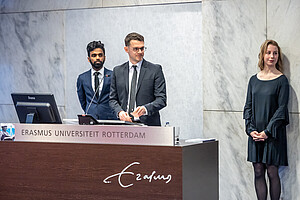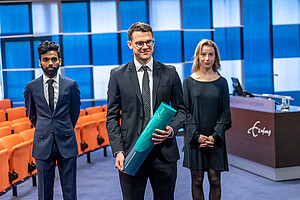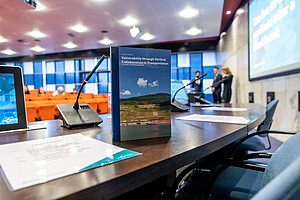PhD Defence Camill Harter

In his dissertation, Vulnerability Through Vertical Collaboration in Transportation: A Complex Networks Approach, ERIM’s Camill Harter showed that vulnerability in collaborative transport networks is strongly influenced by the market structure of carriers; systems with mainly similar-sized carriers are robust to targeted disruption, whereas the total magnitude of potential failure is very large; systems with a few dominating players have a lower magnitude of failure but are highly susceptible to targeted disruption; moreover, there is an optimal level of collaboration where the increasing risk of disruption cascades outweighs the decreasing marginal added benefits of additional collaboration.
Camill defended his dissertation in the Senate Hall at Erasmus University Rotterdam (EUR) on Friday, 10 March 2023. His supervisors were Prof. dr. Rob Zuidwijk (RSM) and Prof. dr. Otto Koppius (RSM). Other members of the Doctoral Committee were Prof. dr. Albert Veenstra (RSM), Prof. dr. Marie Schmidt (Universität Würzburg), Prof. dr. Alexander Verbraeck (TU Delft), Prof. dr. Lóránt Tavasszy (TU Delft), Prof. dr. Violeta Roso (Chalmers), and Prof. dr. Niels Agatz (RSM).
About Camill Harter

Camill was born in Gengenbach, Germany in 1991. He studied Business Mathematics at the University of Mannheim and obtained his M.Sc. degree from there in 2014 with a thesis on the mathematical modeling of criminal movements in urban areas. During his master studies, Camill visited the UPC BarcelonaTech, Spain as a visiting student in the master programme Advanced Mathematics and Mathematical Engineering. After his studies, Camill worked as a consultant at Roland Berger in their Operations Strategy Competence Center for two years. In 2017, Camill started as a PhD candidate at the Technology and Operations Management Department at Rotterdam School of Management, Erasmus University under the supervision of Prof. Rob Zuidwijk and Dr. Otto Koppius.
Camill's research focuses on the modelling of transportation systems with the aim to establish general relationships between changes on the micro-level and their impact on the macro-level. Among the wide range of quantitative methods he is using for his research, the science of complex networks plays a central role. His particular interests include the impact of novel technologies and increased technological integration on the vulnerability of transportation systems. His work has been presented at several international conferences, including INFORMS, LOGMS, NetSci, and CNA.
Thesis Abstract

This research addresses vulnerabilities that emerge from vertical collaboration in complex transportation networks with multiple carriers and transport modes and provides decision support tools for policy making in the field of collaborative transport. Vertical collaboration in our context describes the integration of service networks of different carriers and transport modes, and comes with many benefits such as efficiency, utilization of infrastructure & carbon footprint reduction. However, a higher level of collaboration creates new dependencies, for instance induced by the need for coordination, information exchange, and interconnected information systems, which can ultimately turn into disruption threats. While the benefits of vertical collaboration are extensively covered in existing research, knowledge on the concomitant vulnerabilities has been rather limited. We developed a novel multi-layer network model to capture both the physical and collaborative aspects of transportation networks with vertical collaboration in an integrated fashion and analysed it with a combination of well-known metrics from network science and new methods developed ourselves. We show that vulnerability is strongly influenced by the market structure of carriers. Systems with mainly similar-sized carriers are robust to targeted disruption, whereas the total magnitude of potential failure is very large. Systems with a few dominating carriers have a lower magnitude of failure but are highly susceptible to targeted disruption. Moreover, there is an optimal level of collaboration where the increasing risk of disruption cascades outweighs the decreasing marginal added benefits of additional collaboration.
View photos of Camill's PhD Defence
Photos: Chris Gorzeman / Capital Images


